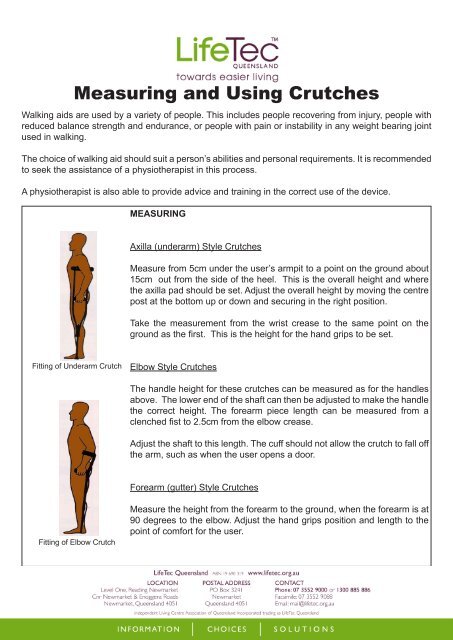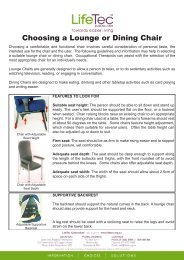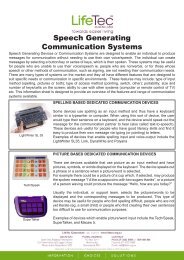Measuring and Using Crutches - LifeTec Queensland
Measuring and Using Crutches - LifeTec Queensland
Measuring and Using Crutches - LifeTec Queensland
Create successful ePaper yourself
Turn your PDF publications into a flip-book with our unique Google optimized e-Paper software.
<strong>Measuring</strong> <strong>and</strong> <strong>Using</strong> <strong>Crutches</strong><br />
Walking aids are used by a variety of people. This includes people recovering from injury, people with<br />
reduced balance strength <strong>and</strong> endurance, or people with pain or instability in any weight bearing joint<br />
used in walking.<br />
The choice of walking aid should suit a person’s abilities <strong>and</strong> personal requirements. It is recommended<br />
to seek the assistance of a physiotherapist in this process.<br />
A physiotherapist is also able to provide advice <strong>and</strong> training in the correct use of the device.<br />
Fitting of Underarm Crutch<br />
Fitting of Elbow Crutch<br />
MEASURING<br />
Axilla (underarm) Style <strong>Crutches</strong><br />
Measure from 5cm under the user’s armpit to a point on the ground about<br />
15cm out from the side of the heel. This is the overall height <strong>and</strong> where<br />
the axilla pad should be set. Adjust the overall height by moving the centre<br />
post at the bottom up or down <strong>and</strong> securing in the right position.<br />
Take the measurement from the wrist crease to the same point on the<br />
ground as the first. This is the height for the h<strong>and</strong> grips to be set.<br />
Elbow Style <strong>Crutches</strong><br />
The h<strong>and</strong>le height for these crutches can be measured as for the h<strong>and</strong>les<br />
above. The lower end of the shaft can then be adjusted to make the h<strong>and</strong>le<br />
the correct height. The forearm piece length can be measured from a<br />
clenched fist to 2.5cm from the elbow crease.<br />
Adjust the shaft to this length. The cuff should not allow the crutch to fall off<br />
the arm, such as when the user opens a door.<br />
Forearm (gutter) Style <strong>Crutches</strong><br />
Measure the height from the forearm to the ground, when the forearm is at<br />
90 degrees to the elbow. Adjust the h<strong>and</strong> grips position <strong>and</strong> length to the<br />
point of comfort for the user.
SAFETY<br />
Axilla <strong>Crutches</strong><br />
Figure One (1)<br />
Figure Two (2)<br />
USE<br />
The weight should be taken through the h<strong>and</strong>s on the h<strong>and</strong> pads (or the<br />
forearms in the case of gutter crutches). The axilla pads should be pressed<br />
against the chest wall, not high under the armpits.<br />
The crutches should be positioned slightly to the side <strong>and</strong> forward to<br />
maintain a stable base.<br />
If the affected leg is to be partial weight bearing, then the user should place<br />
the crutches forward, then the affected leg, then share the load between<br />
the crutches <strong>and</strong> that leg while the unaffected leg is brought forward.<br />
A four-point gait may be used for general weakness <strong>and</strong> is slow <strong>and</strong> safe.<br />
This involves putting one crutch forward, then the opposite leg, then the<br />
other crutch forward of the first one, followed by the other leg. (see figure<br />
1)<br />
If the user is not to bear any weight through the affected leg, then both<br />
crutches should be put forward <strong>and</strong> the user should hop towards the space<br />
between them, to just behind the crutches. (see figure 2) The affected leg<br />
should be held in front of the body clear of the ground.<br />
Forearm crutches can be unstable with a full load, <strong>and</strong> may not be<br />
recommended for non-weight bearing use.<br />
STEPS AND STAIRS<br />
Going Up:<br />
Lift the unaffected leg up the step first while taking the weight on the crutches<br />
<strong>and</strong> the affected leg if bearing partial weight on it.<br />
Then bring the crutches <strong>and</strong> the affected leg onto the same step.<br />
Going Down:<br />
Lower the affected leg <strong>and</strong> the crutches down the step first, then bring the<br />
unaffected leg down to the same step.<br />
• Do not let axilla crutches press under the arms, as this can cause damage to important fragile<br />
nerves there.<br />
• Concentrate when using crutches, especially when non weight bearing.<br />
• Keep the rubber tips in good condition.<br />
• Be extra careful in wet areas <strong>and</strong> on uneven ground.<br />
• Make sure all fastenings are secured tightly.<br />
NEED TO KNOW MORE?<br />
Telephone, fax or e-mail your enquiry to obtain further information from an occupational therapist<br />
about products. Alternatively, you can call <strong>LifeTec</strong> Queensl<strong>and</strong> to make an appointment to see or trial<br />
equipment at the our display centre or possibly to try equipment through the outreach service.




